MGT300: Johnston of Elgin Logistics Management Report Analysis
VerifiedAdded on 2023/06/10
|15
|3653
|258
Report
AI Summary
This report provides a comprehensive analysis of Johnston of Elgin's logistics management, focusing on the challenges faced by the company, including low-cost and time-based competition. It examines the strategies implemented to enhance its position, such as vertical integration, driving efficiencies in supply chain mechanisms, and employing upstream to downstream production processes. The report also discusses the implementation of agile and lean logistics strategies. A SWOT analysis is presented, along with recommendations for addressing the identified issues. The study delves into the evolution of the company's supply chain, the importance of its skilled workforce, and the impact of its strategic shifts. The report highlights the company's ability to adapt and maintain its competitive advantage in the textile industry.
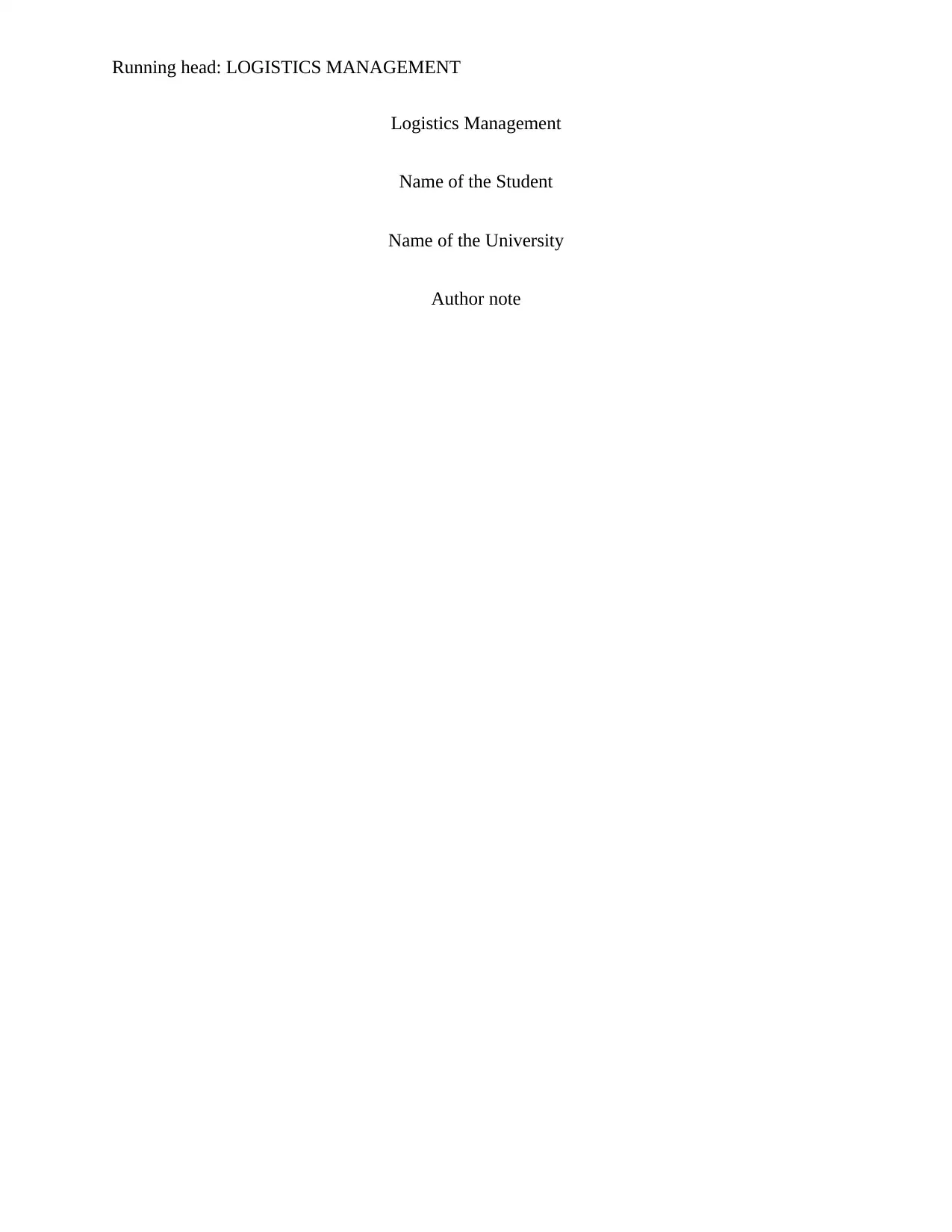
Running head: LOGISTICS MANAGEMENT
Logistics Management
Name of the Student
Name of the University
Author note
Logistics Management
Name of the Student
Name of the University
Author note
Paraphrase This Document
Need a fresh take? Get an instant paraphrase of this document with our AI Paraphraser
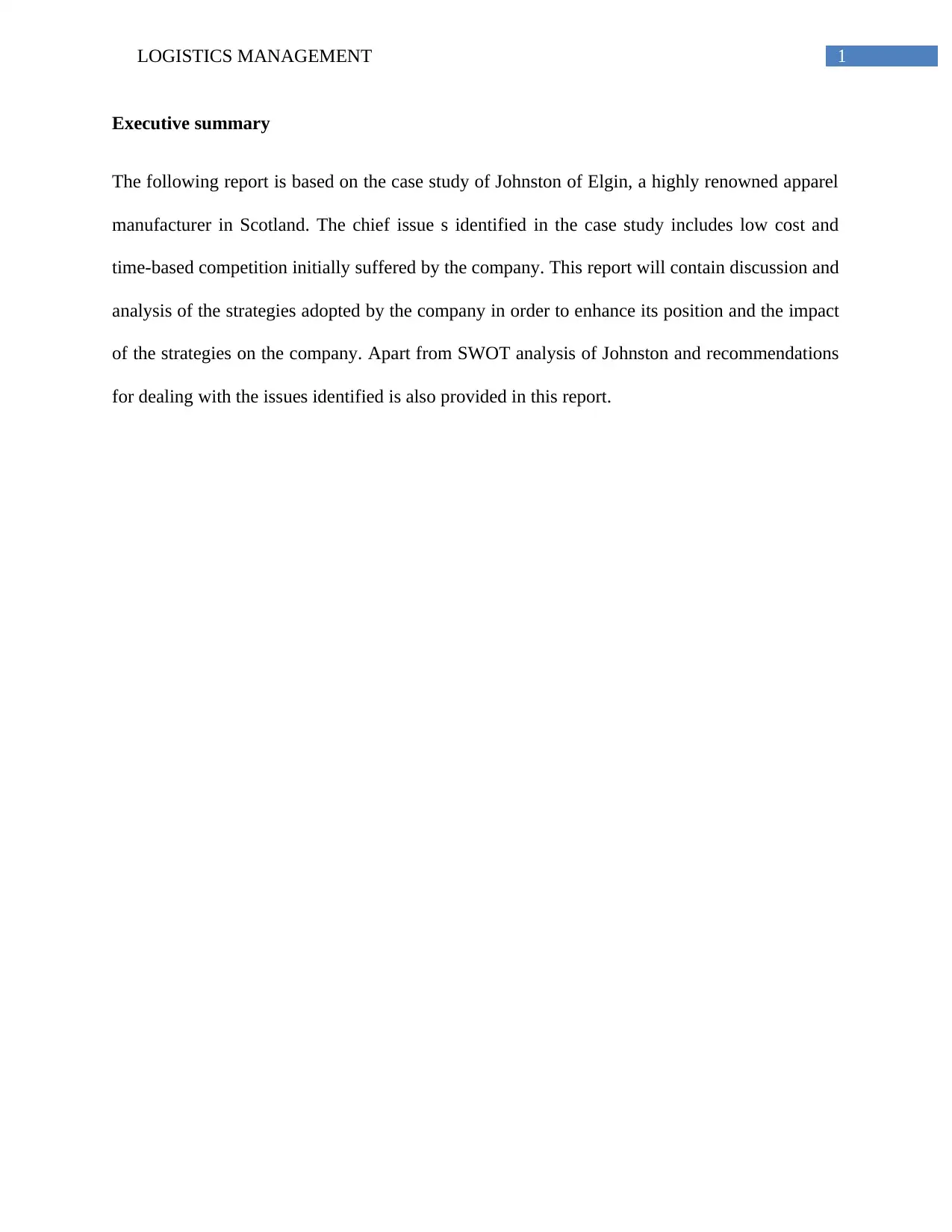
1LOGISTICS MANAGEMENT
Executive summary
The following report is based on the case study of Johnston of Elgin, a highly renowned apparel
manufacturer in Scotland. The chief issue s identified in the case study includes low cost and
time-based competition initially suffered by the company. This report will contain discussion and
analysis of the strategies adopted by the company in order to enhance its position and the impact
of the strategies on the company. Apart from SWOT analysis of Johnston and recommendations
for dealing with the issues identified is also provided in this report.
Executive summary
The following report is based on the case study of Johnston of Elgin, a highly renowned apparel
manufacturer in Scotland. The chief issue s identified in the case study includes low cost and
time-based competition initially suffered by the company. This report will contain discussion and
analysis of the strategies adopted by the company in order to enhance its position and the impact
of the strategies on the company. Apart from SWOT analysis of Johnston and recommendations
for dealing with the issues identified is also provided in this report.

2LOGISTICS MANAGEMENT
Table of Contents
Introduction:....................................................................................................................................3
Discussion:.......................................................................................................................................3
Issues faced by the Johnston Cashmere.......................................................................................3
Low-cost competition:.............................................................................................................4
Time-based competition:.........................................................................................................4
Shifting the focus:....................................................................................................................4
Strategies developed by Johnston Cashmere to enhance its profit..............................................5
Vertical integration..................................................................................................................5
Driving efficiencies and supply chain mechanisms.................................................................6
Employing, upstream to downstream production and finishing processes..............................7
Agile and lean logistics strategies............................................................................................8
SWOT analysis of the Company.................................................................................................9
Conclusion:....................................................................................................................................10
Recommendation:..........................................................................................................................11
Reference list.................................................................................................................................12
Table of Contents
Introduction:....................................................................................................................................3
Discussion:.......................................................................................................................................3
Issues faced by the Johnston Cashmere.......................................................................................3
Low-cost competition:.............................................................................................................4
Time-based competition:.........................................................................................................4
Shifting the focus:....................................................................................................................4
Strategies developed by Johnston Cashmere to enhance its profit..............................................5
Vertical integration..................................................................................................................5
Driving efficiencies and supply chain mechanisms.................................................................6
Employing, upstream to downstream production and finishing processes..............................7
Agile and lean logistics strategies............................................................................................8
SWOT analysis of the Company.................................................................................................9
Conclusion:....................................................................................................................................10
Recommendation:..........................................................................................................................11
Reference list.................................................................................................................................12
⊘ This is a preview!⊘
Do you want full access?
Subscribe today to unlock all pages.

Trusted by 1+ million students worldwide
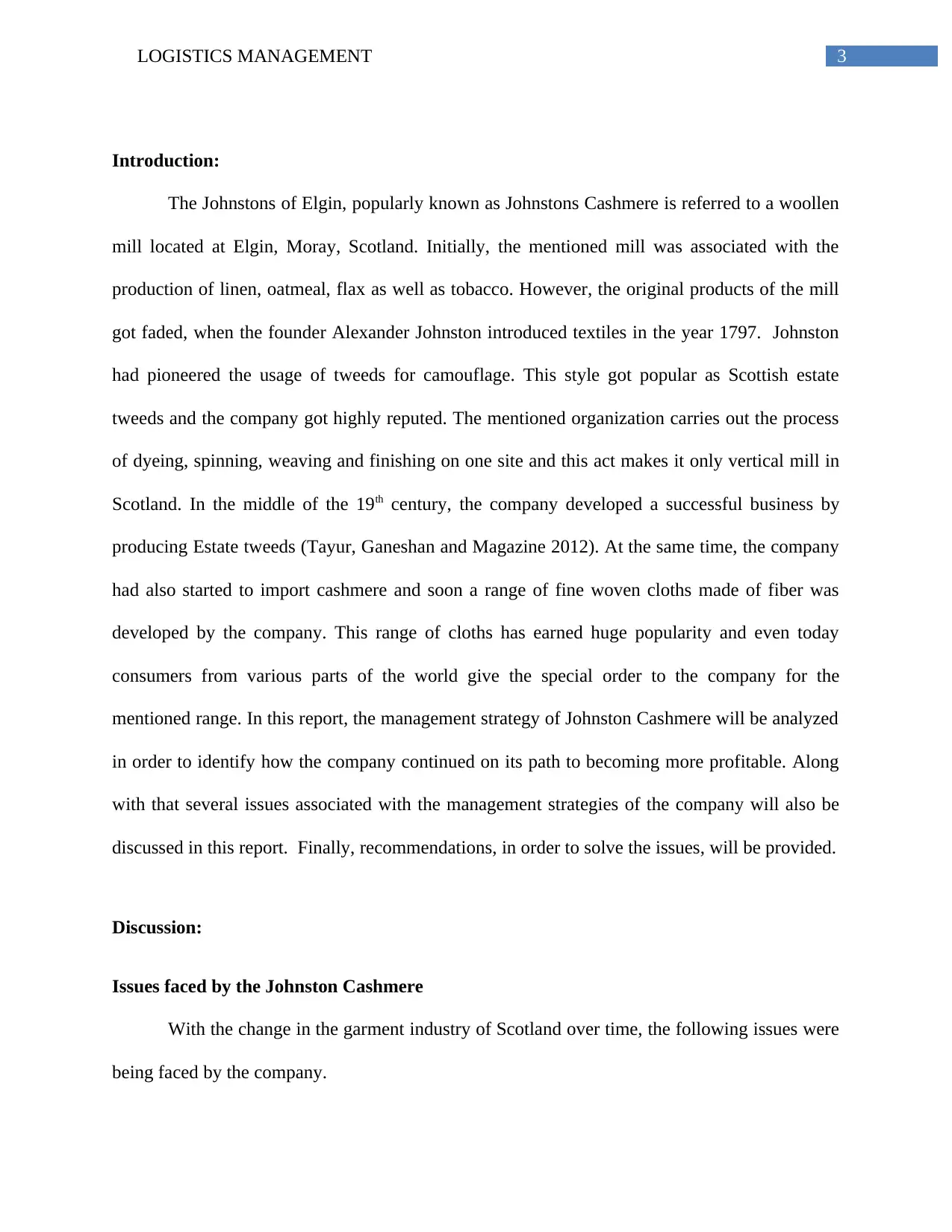
3LOGISTICS MANAGEMENT
Introduction:
The Johnstons of Elgin, popularly known as Johnstons Cashmere is referred to a woollen
mill located at Elgin, Moray, Scotland. Initially, the mentioned mill was associated with the
production of linen, oatmeal, flax as well as tobacco. However, the original products of the mill
got faded, when the founder Alexander Johnston introduced textiles in the year 1797. Johnston
had pioneered the usage of tweeds for camouflage. This style got popular as Scottish estate
tweeds and the company got highly reputed. The mentioned organization carries out the process
of dyeing, spinning, weaving and finishing on one site and this act makes it only vertical mill in
Scotland. In the middle of the 19th century, the company developed a successful business by
producing Estate tweeds (Tayur, Ganeshan and Magazine 2012). At the same time, the company
had also started to import cashmere and soon a range of fine woven cloths made of fiber was
developed by the company. This range of cloths has earned huge popularity and even today
consumers from various parts of the world give the special order to the company for the
mentioned range. In this report, the management strategy of Johnston Cashmere will be analyzed
in order to identify how the company continued on its path to becoming more profitable. Along
with that several issues associated with the management strategies of the company will also be
discussed in this report. Finally, recommendations, in order to solve the issues, will be provided.
Discussion:
Issues faced by the Johnston Cashmere
With the change in the garment industry of Scotland over time, the following issues were
being faced by the company.
Introduction:
The Johnstons of Elgin, popularly known as Johnstons Cashmere is referred to a woollen
mill located at Elgin, Moray, Scotland. Initially, the mentioned mill was associated with the
production of linen, oatmeal, flax as well as tobacco. However, the original products of the mill
got faded, when the founder Alexander Johnston introduced textiles in the year 1797. Johnston
had pioneered the usage of tweeds for camouflage. This style got popular as Scottish estate
tweeds and the company got highly reputed. The mentioned organization carries out the process
of dyeing, spinning, weaving and finishing on one site and this act makes it only vertical mill in
Scotland. In the middle of the 19th century, the company developed a successful business by
producing Estate tweeds (Tayur, Ganeshan and Magazine 2012). At the same time, the company
had also started to import cashmere and soon a range of fine woven cloths made of fiber was
developed by the company. This range of cloths has earned huge popularity and even today
consumers from various parts of the world give the special order to the company for the
mentioned range. In this report, the management strategy of Johnston Cashmere will be analyzed
in order to identify how the company continued on its path to becoming more profitable. Along
with that several issues associated with the management strategies of the company will also be
discussed in this report. Finally, recommendations, in order to solve the issues, will be provided.
Discussion:
Issues faced by the Johnston Cashmere
With the change in the garment industry of Scotland over time, the following issues were
being faced by the company.
Paraphrase This Document
Need a fresh take? Get an instant paraphrase of this document with our AI Paraphraser
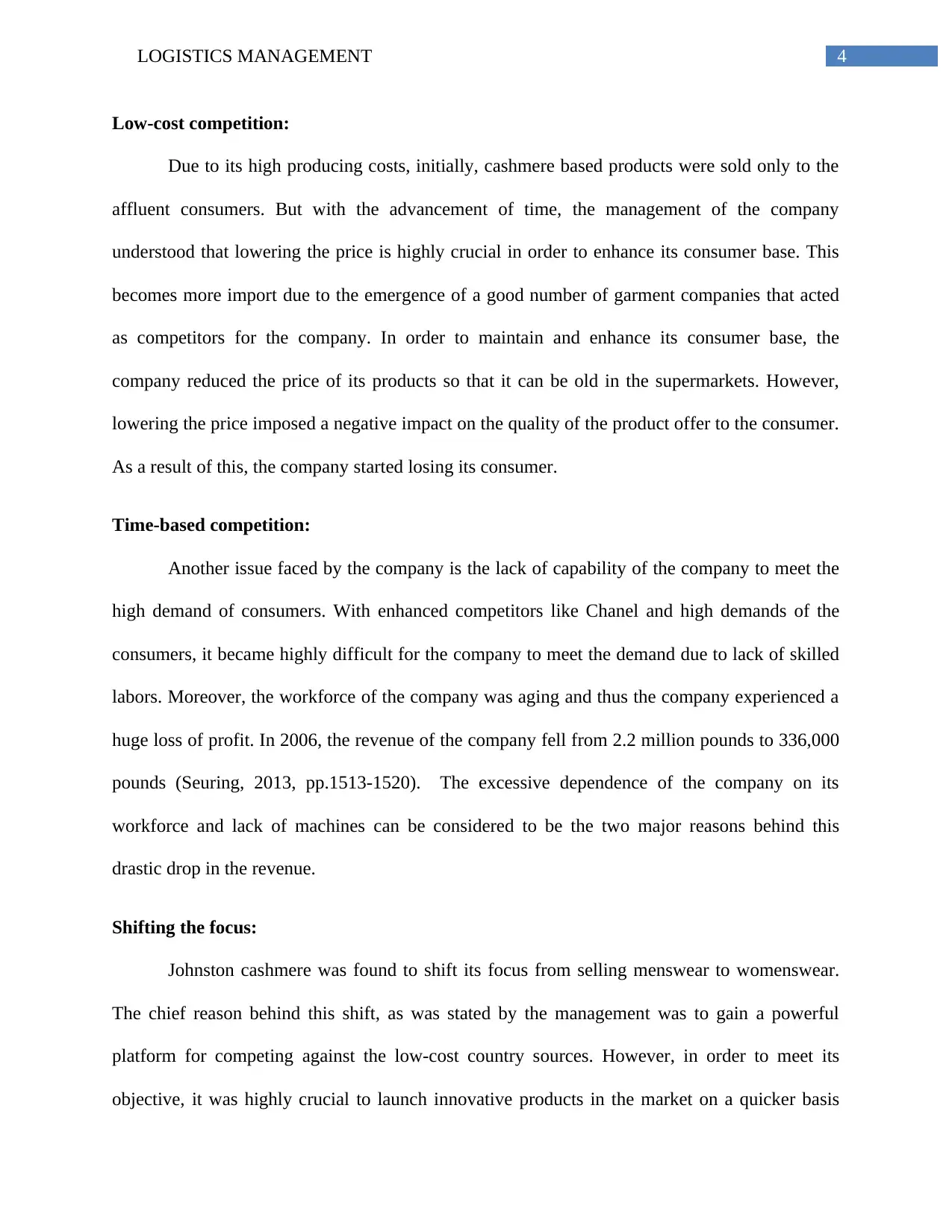
4LOGISTICS MANAGEMENT
Low-cost competition:
Due to its high producing costs, initially, cashmere based products were sold only to the
affluent consumers. But with the advancement of time, the management of the company
understood that lowering the price is highly crucial in order to enhance its consumer base. This
becomes more import due to the emergence of a good number of garment companies that acted
as competitors for the company. In order to maintain and enhance its consumer base, the
company reduced the price of its products so that it can be old in the supermarkets. However,
lowering the price imposed a negative impact on the quality of the product offer to the consumer.
As a result of this, the company started losing its consumer.
Time-based competition:
Another issue faced by the company is the lack of capability of the company to meet the
high demand of consumers. With enhanced competitors like Chanel and high demands of the
consumers, it became highly difficult for the company to meet the demand due to lack of skilled
labors. Moreover, the workforce of the company was aging and thus the company experienced a
huge loss of profit. In 2006, the revenue of the company fell from 2.2 million pounds to 336,000
pounds (Seuring, 2013, pp.1513-1520). The excessive dependence of the company on its
workforce and lack of machines can be considered to be the two major reasons behind this
drastic drop in the revenue.
Shifting the focus:
Johnston cashmere was found to shift its focus from selling menswear to womenswear.
The chief reason behind this shift, as was stated by the management was to gain a powerful
platform for competing against the low-cost country sources. However, in order to meet its
objective, it was highly crucial to launch innovative products in the market on a quicker basis
Low-cost competition:
Due to its high producing costs, initially, cashmere based products were sold only to the
affluent consumers. But with the advancement of time, the management of the company
understood that lowering the price is highly crucial in order to enhance its consumer base. This
becomes more import due to the emergence of a good number of garment companies that acted
as competitors for the company. In order to maintain and enhance its consumer base, the
company reduced the price of its products so that it can be old in the supermarkets. However,
lowering the price imposed a negative impact on the quality of the product offer to the consumer.
As a result of this, the company started losing its consumer.
Time-based competition:
Another issue faced by the company is the lack of capability of the company to meet the
high demand of consumers. With enhanced competitors like Chanel and high demands of the
consumers, it became highly difficult for the company to meet the demand due to lack of skilled
labors. Moreover, the workforce of the company was aging and thus the company experienced a
huge loss of profit. In 2006, the revenue of the company fell from 2.2 million pounds to 336,000
pounds (Seuring, 2013, pp.1513-1520). The excessive dependence of the company on its
workforce and lack of machines can be considered to be the two major reasons behind this
drastic drop in the revenue.
Shifting the focus:
Johnston cashmere was found to shift its focus from selling menswear to womenswear.
The chief reason behind this shift, as was stated by the management was to gain a powerful
platform for competing against the low-cost country sources. However, in order to meet its
objective, it was highly crucial to launch innovative products in the market on a quicker basis
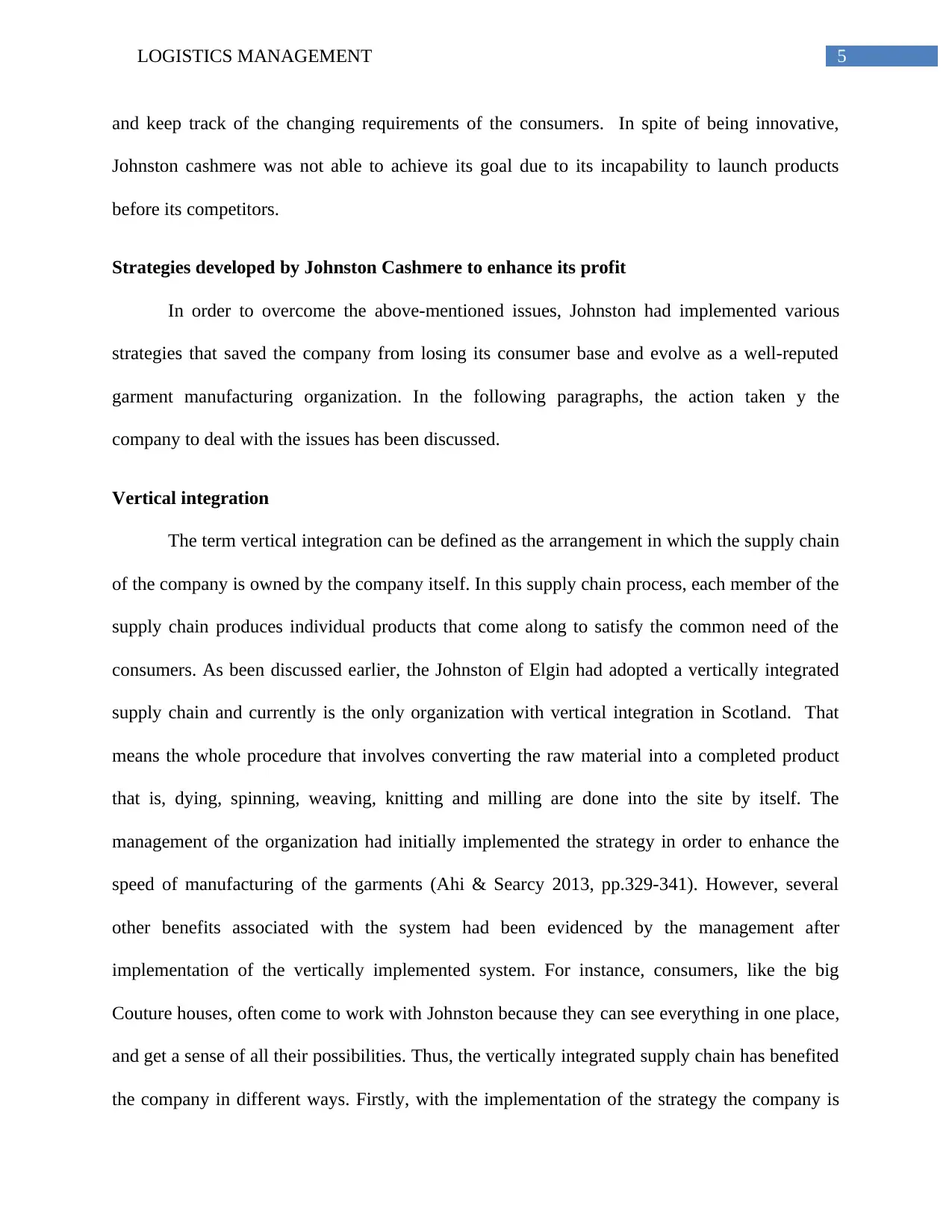
5LOGISTICS MANAGEMENT
and keep track of the changing requirements of the consumers. In spite of being innovative,
Johnston cashmere was not able to achieve its goal due to its incapability to launch products
before its competitors.
Strategies developed by Johnston Cashmere to enhance its profit
In order to overcome the above-mentioned issues, Johnston had implemented various
strategies that saved the company from losing its consumer base and evolve as a well-reputed
garment manufacturing organization. In the following paragraphs, the action taken y the
company to deal with the issues has been discussed.
Vertical integration
The term vertical integration can be defined as the arrangement in which the supply chain
of the company is owned by the company itself. In this supply chain process, each member of the
supply chain produces individual products that come along to satisfy the common need of the
consumers. As been discussed earlier, the Johnston of Elgin had adopted a vertically integrated
supply chain and currently is the only organization with vertical integration in Scotland. That
means the whole procedure that involves converting the raw material into a completed product
that is, dying, spinning, weaving, knitting and milling are done into the site by itself. The
management of the organization had initially implemented the strategy in order to enhance the
speed of manufacturing of the garments (Ahi & Searcy 2013, pp.329-341). However, several
other benefits associated with the system had been evidenced by the management after
implementation of the vertically implemented system. For instance, consumers, like the big
Couture houses, often come to work with Johnston because they can see everything in one place,
and get a sense of all their possibilities. Thus, the vertically integrated supply chain has benefited
the company in different ways. Firstly, with the implementation of the strategy the company is
and keep track of the changing requirements of the consumers. In spite of being innovative,
Johnston cashmere was not able to achieve its goal due to its incapability to launch products
before its competitors.
Strategies developed by Johnston Cashmere to enhance its profit
In order to overcome the above-mentioned issues, Johnston had implemented various
strategies that saved the company from losing its consumer base and evolve as a well-reputed
garment manufacturing organization. In the following paragraphs, the action taken y the
company to deal with the issues has been discussed.
Vertical integration
The term vertical integration can be defined as the arrangement in which the supply chain
of the company is owned by the company itself. In this supply chain process, each member of the
supply chain produces individual products that come along to satisfy the common need of the
consumers. As been discussed earlier, the Johnston of Elgin had adopted a vertically integrated
supply chain and currently is the only organization with vertical integration in Scotland. That
means the whole procedure that involves converting the raw material into a completed product
that is, dying, spinning, weaving, knitting and milling are done into the site by itself. The
management of the organization had initially implemented the strategy in order to enhance the
speed of manufacturing of the garments (Ahi & Searcy 2013, pp.329-341). However, several
other benefits associated with the system had been evidenced by the management after
implementation of the vertically implemented system. For instance, consumers, like the big
Couture houses, often come to work with Johnston because they can see everything in one place,
and get a sense of all their possibilities. Thus, the vertically integrated supply chain has benefited
the company in different ways. Firstly, with the implementation of the strategy the company is
⊘ This is a preview!⊘
Do you want full access?
Subscribe today to unlock all pages.

Trusted by 1+ million students worldwide
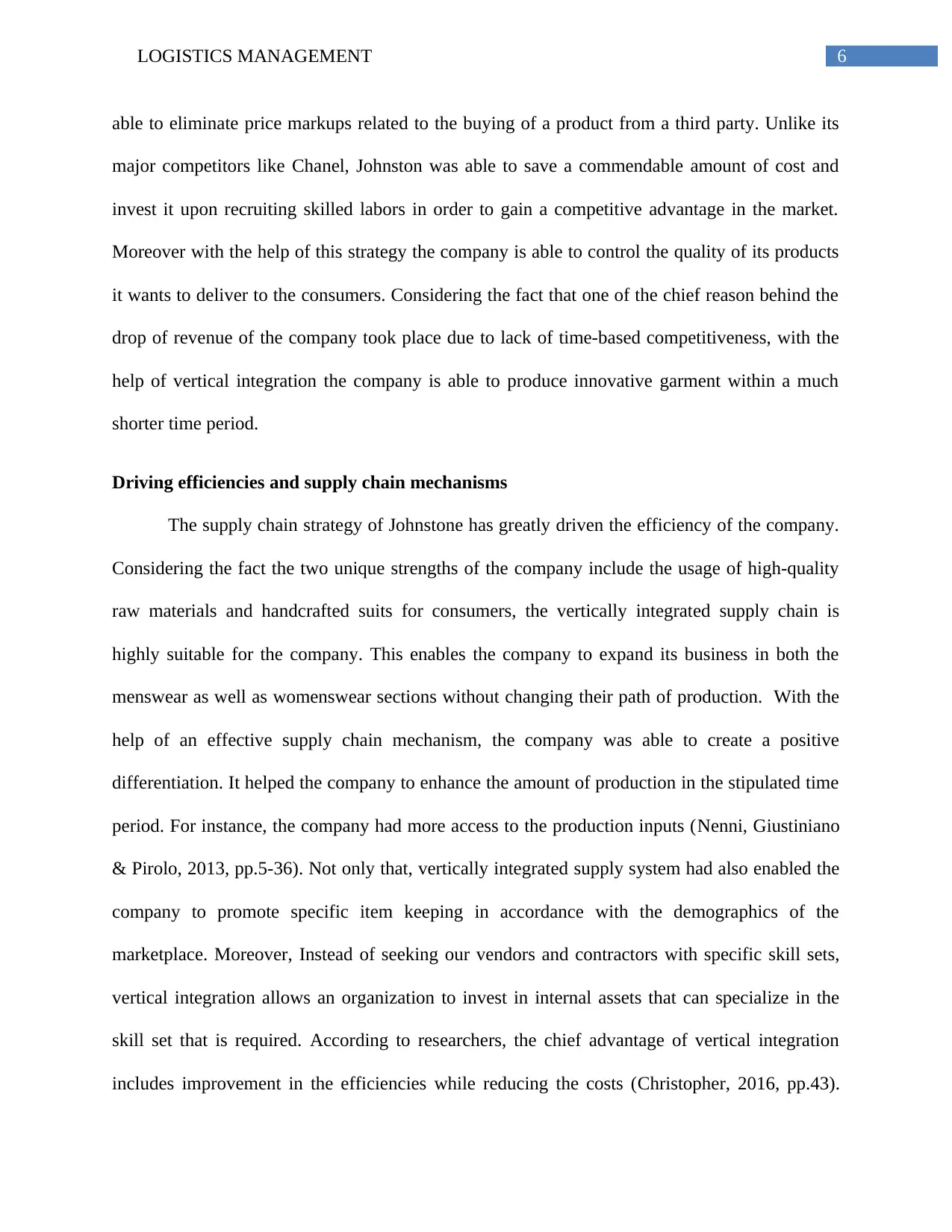
6LOGISTICS MANAGEMENT
able to eliminate price markups related to the buying of a product from a third party. Unlike its
major competitors like Chanel, Johnston was able to save a commendable amount of cost and
invest it upon recruiting skilled labors in order to gain a competitive advantage in the market.
Moreover with the help of this strategy the company is able to control the quality of its products
it wants to deliver to the consumers. Considering the fact that one of the chief reason behind the
drop of revenue of the company took place due to lack of time-based competitiveness, with the
help of vertical integration the company is able to produce innovative garment within a much
shorter time period.
Driving efficiencies and supply chain mechanisms
The supply chain strategy of Johnstone has greatly driven the efficiency of the company.
Considering the fact the two unique strengths of the company include the usage of high-quality
raw materials and handcrafted suits for consumers, the vertically integrated supply chain is
highly suitable for the company. This enables the company to expand its business in both the
menswear as well as womenswear sections without changing their path of production. With the
help of an effective supply chain mechanism, the company was able to create a positive
differentiation. It helped the company to enhance the amount of production in the stipulated time
period. For instance, the company had more access to the production inputs (Nenni, Giustiniano
& Pirolo, 2013, pp.5-36). Not only that, vertically integrated supply system had also enabled the
company to promote specific item keeping in accordance with the demographics of the
marketplace. Moreover, Instead of seeking our vendors and contractors with specific skill sets,
vertical integration allows an organization to invest in internal assets that can specialize in the
skill set that is required. According to researchers, the chief advantage of vertical integration
includes improvement in the efficiencies while reducing the costs (Christopher, 2016, pp.43).
able to eliminate price markups related to the buying of a product from a third party. Unlike its
major competitors like Chanel, Johnston was able to save a commendable amount of cost and
invest it upon recruiting skilled labors in order to gain a competitive advantage in the market.
Moreover with the help of this strategy the company is able to control the quality of its products
it wants to deliver to the consumers. Considering the fact that one of the chief reason behind the
drop of revenue of the company took place due to lack of time-based competitiveness, with the
help of vertical integration the company is able to produce innovative garment within a much
shorter time period.
Driving efficiencies and supply chain mechanisms
The supply chain strategy of Johnstone has greatly driven the efficiency of the company.
Considering the fact the two unique strengths of the company include the usage of high-quality
raw materials and handcrafted suits for consumers, the vertically integrated supply chain is
highly suitable for the company. This enables the company to expand its business in both the
menswear as well as womenswear sections without changing their path of production. With the
help of an effective supply chain mechanism, the company was able to create a positive
differentiation. It helped the company to enhance the amount of production in the stipulated time
period. For instance, the company had more access to the production inputs (Nenni, Giustiniano
& Pirolo, 2013, pp.5-36). Not only that, vertically integrated supply system had also enabled the
company to promote specific item keeping in accordance with the demographics of the
marketplace. Moreover, Instead of seeking our vendors and contractors with specific skill sets,
vertical integration allows an organization to invest in internal assets that can specialize in the
skill set that is required. According to researchers, the chief advantage of vertical integration
includes improvement in the efficiencies while reducing the costs (Christopher, 2016, pp.43).
Paraphrase This Document
Need a fresh take? Get an instant paraphrase of this document with our AI Paraphraser
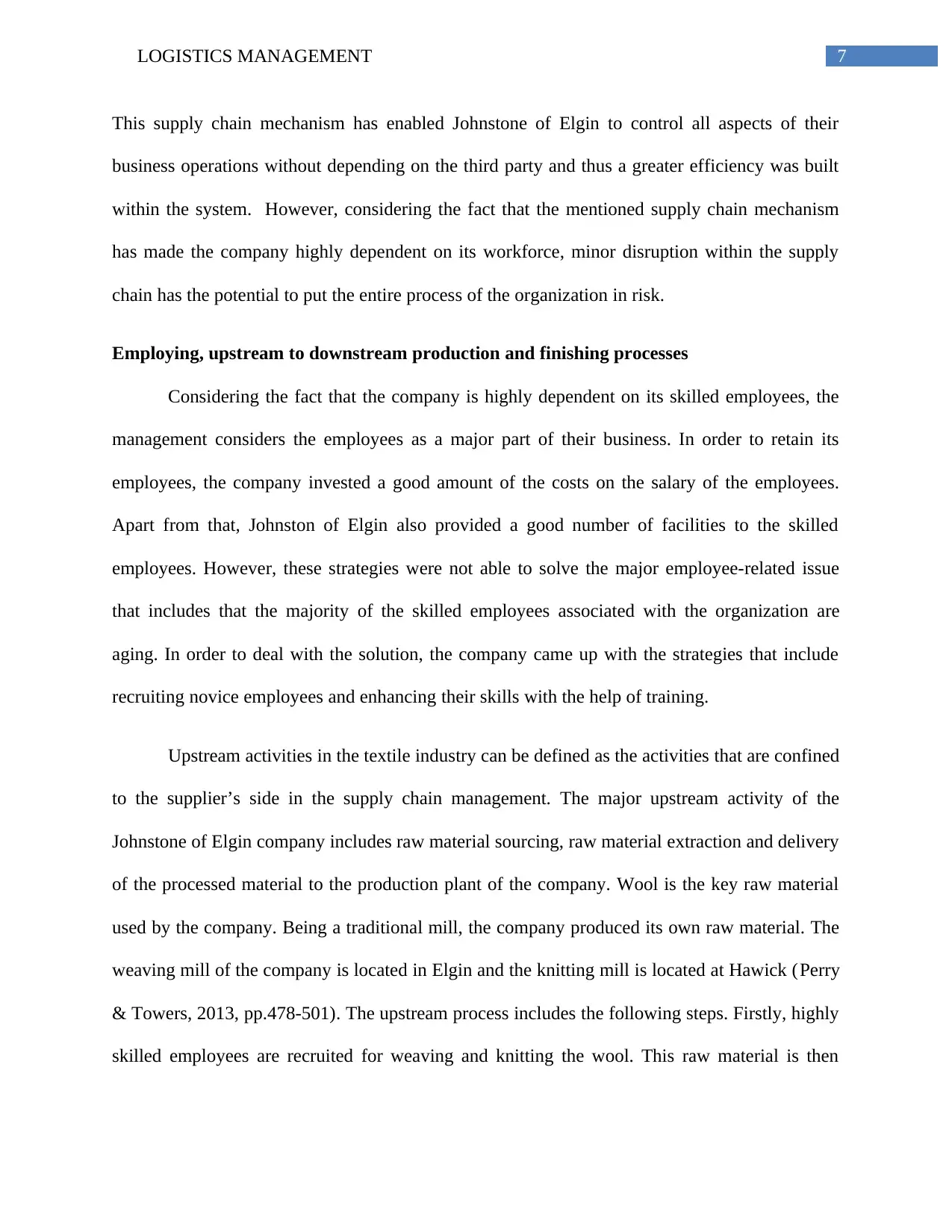
7LOGISTICS MANAGEMENT
This supply chain mechanism has enabled Johnstone of Elgin to control all aspects of their
business operations without depending on the third party and thus a greater efficiency was built
within the system. However, considering the fact that the mentioned supply chain mechanism
has made the company highly dependent on its workforce, minor disruption within the supply
chain has the potential to put the entire process of the organization in risk.
Employing, upstream to downstream production and finishing processes
Considering the fact that the company is highly dependent on its skilled employees, the
management considers the employees as a major part of their business. In order to retain its
employees, the company invested a good amount of the costs on the salary of the employees.
Apart from that, Johnston of Elgin also provided a good number of facilities to the skilled
employees. However, these strategies were not able to solve the major employee-related issue
that includes that the majority of the skilled employees associated with the organization are
aging. In order to deal with the solution, the company came up with the strategies that include
recruiting novice employees and enhancing their skills with the help of training.
Upstream activities in the textile industry can be defined as the activities that are confined
to the supplier’s side in the supply chain management. The major upstream activity of the
Johnstone of Elgin company includes raw material sourcing, raw material extraction and delivery
of the processed material to the production plant of the company. Wool is the key raw material
used by the company. Being a traditional mill, the company produced its own raw material. The
weaving mill of the company is located in Elgin and the knitting mill is located at Hawick (Perry
& Towers, 2013, pp.478-501). The upstream process includes the following steps. Firstly, highly
skilled employees are recruited for weaving and knitting the wool. This raw material is then
This supply chain mechanism has enabled Johnstone of Elgin to control all aspects of their
business operations without depending on the third party and thus a greater efficiency was built
within the system. However, considering the fact that the mentioned supply chain mechanism
has made the company highly dependent on its workforce, minor disruption within the supply
chain has the potential to put the entire process of the organization in risk.
Employing, upstream to downstream production and finishing processes
Considering the fact that the company is highly dependent on its skilled employees, the
management considers the employees as a major part of their business. In order to retain its
employees, the company invested a good amount of the costs on the salary of the employees.
Apart from that, Johnston of Elgin also provided a good number of facilities to the skilled
employees. However, these strategies were not able to solve the major employee-related issue
that includes that the majority of the skilled employees associated with the organization are
aging. In order to deal with the solution, the company came up with the strategies that include
recruiting novice employees and enhancing their skills with the help of training.
Upstream activities in the textile industry can be defined as the activities that are confined
to the supplier’s side in the supply chain management. The major upstream activity of the
Johnstone of Elgin company includes raw material sourcing, raw material extraction and delivery
of the processed material to the production plant of the company. Wool is the key raw material
used by the company. Being a traditional mill, the company produced its own raw material. The
weaving mill of the company is located in Elgin and the knitting mill is located at Hawick (Perry
& Towers, 2013, pp.478-501). The upstream process includes the following steps. Firstly, highly
skilled employees are recruited for weaving and knitting the wool. This raw material is then
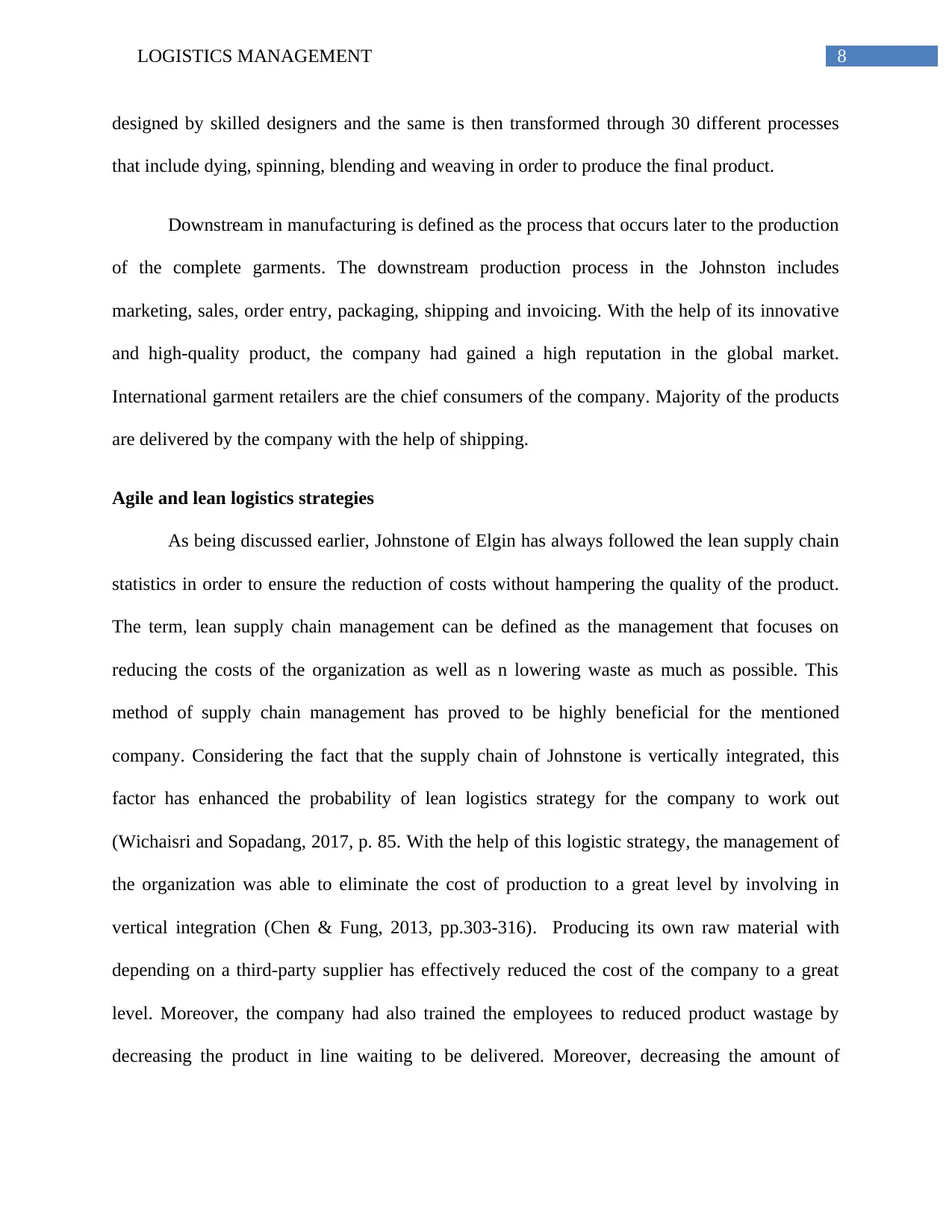
8LOGISTICS MANAGEMENT
designed by skilled designers and the same is then transformed through 30 different processes
that include dying, spinning, blending and weaving in order to produce the final product.
Downstream in manufacturing is defined as the process that occurs later to the production
of the complete garments. The downstream production process in the Johnston includes
marketing, sales, order entry, packaging, shipping and invoicing. With the help of its innovative
and high-quality product, the company had gained a high reputation in the global market.
International garment retailers are the chief consumers of the company. Majority of the products
are delivered by the company with the help of shipping.
Agile and lean logistics strategies
As being discussed earlier, Johnstone of Elgin has always followed the lean supply chain
statistics in order to ensure the reduction of costs without hampering the quality of the product.
The term, lean supply chain management can be defined as the management that focuses on
reducing the costs of the organization as well as n lowering waste as much as possible. This
method of supply chain management has proved to be highly beneficial for the mentioned
company. Considering the fact that the supply chain of Johnstone is vertically integrated, this
factor has enhanced the probability of lean logistics strategy for the company to work out
(Wichaisri and Sopadang, 2017, p. 85. With the help of this logistic strategy, the management of
the organization was able to eliminate the cost of production to a great level by involving in
vertical integration (Chen & Fung, 2013, pp.303-316). Producing its own raw material with
depending on a third-party supplier has effectively reduced the cost of the company to a great
level. Moreover, the company had also trained the employees to reduced product wastage by
decreasing the product in line waiting to be delivered. Moreover, decreasing the amount of
designed by skilled designers and the same is then transformed through 30 different processes
that include dying, spinning, blending and weaving in order to produce the final product.
Downstream in manufacturing is defined as the process that occurs later to the production
of the complete garments. The downstream production process in the Johnston includes
marketing, sales, order entry, packaging, shipping and invoicing. With the help of its innovative
and high-quality product, the company had gained a high reputation in the global market.
International garment retailers are the chief consumers of the company. Majority of the products
are delivered by the company with the help of shipping.
Agile and lean logistics strategies
As being discussed earlier, Johnstone of Elgin has always followed the lean supply chain
statistics in order to ensure the reduction of costs without hampering the quality of the product.
The term, lean supply chain management can be defined as the management that focuses on
reducing the costs of the organization as well as n lowering waste as much as possible. This
method of supply chain management has proved to be highly beneficial for the mentioned
company. Considering the fact that the supply chain of Johnstone is vertically integrated, this
factor has enhanced the probability of lean logistics strategy for the company to work out
(Wichaisri and Sopadang, 2017, p. 85. With the help of this logistic strategy, the management of
the organization was able to eliminate the cost of production to a great level by involving in
vertical integration (Chen & Fung, 2013, pp.303-316). Producing its own raw material with
depending on a third-party supplier has effectively reduced the cost of the company to a great
level. Moreover, the company had also trained the employees to reduced product wastage by
decreasing the product in line waiting to be delivered. Moreover, decreasing the amount of
⊘ This is a preview!⊘
Do you want full access?
Subscribe today to unlock all pages.

Trusted by 1+ million students worldwide
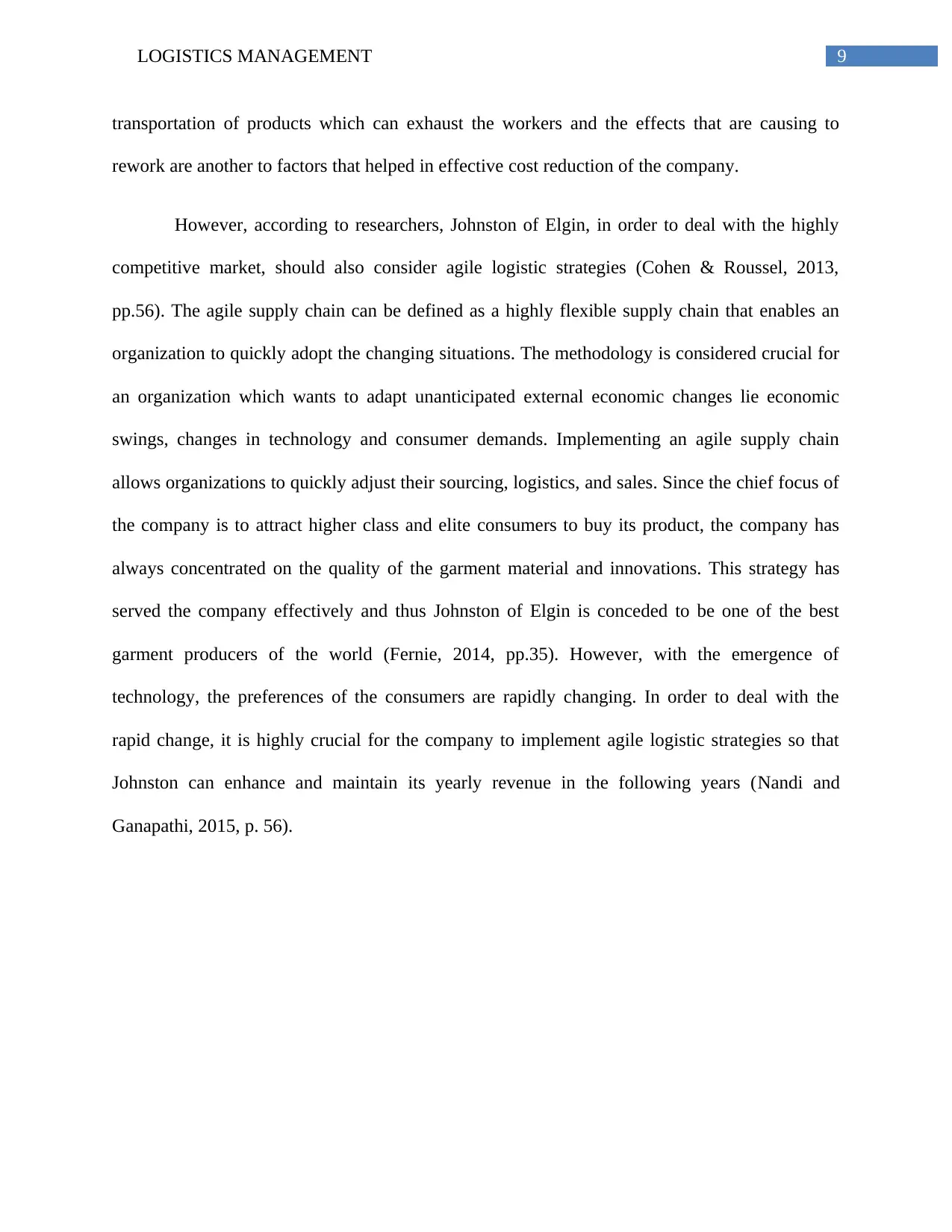
9LOGISTICS MANAGEMENT
transportation of products which can exhaust the workers and the effects that are causing to
rework are another to factors that helped in effective cost reduction of the company.
However, according to researchers, Johnston of Elgin, in order to deal with the highly
competitive market, should also consider agile logistic strategies (Cohen & Roussel, 2013,
pp.56). The agile supply chain can be defined as a highly flexible supply chain that enables an
organization to quickly adopt the changing situations. The methodology is considered crucial for
an organization which wants to adapt unanticipated external economic changes lie economic
swings, changes in technology and consumer demands. Implementing an agile supply chain
allows organizations to quickly adjust their sourcing, logistics, and sales. Since the chief focus of
the company is to attract higher class and elite consumers to buy its product, the company has
always concentrated on the quality of the garment material and innovations. This strategy has
served the company effectively and thus Johnston of Elgin is conceded to be one of the best
garment producers of the world (Fernie, 2014, pp.35). However, with the emergence of
technology, the preferences of the consumers are rapidly changing. In order to deal with the
rapid change, it is highly crucial for the company to implement agile logistic strategies so that
Johnston can enhance and maintain its yearly revenue in the following years (Nandi and
Ganapathi, 2015, p. 56).
transportation of products which can exhaust the workers and the effects that are causing to
rework are another to factors that helped in effective cost reduction of the company.
However, according to researchers, Johnston of Elgin, in order to deal with the highly
competitive market, should also consider agile logistic strategies (Cohen & Roussel, 2013,
pp.56). The agile supply chain can be defined as a highly flexible supply chain that enables an
organization to quickly adopt the changing situations. The methodology is considered crucial for
an organization which wants to adapt unanticipated external economic changes lie economic
swings, changes in technology and consumer demands. Implementing an agile supply chain
allows organizations to quickly adjust their sourcing, logistics, and sales. Since the chief focus of
the company is to attract higher class and elite consumers to buy its product, the company has
always concentrated on the quality of the garment material and innovations. This strategy has
served the company effectively and thus Johnston of Elgin is conceded to be one of the best
garment producers of the world (Fernie, 2014, pp.35). However, with the emergence of
technology, the preferences of the consumers are rapidly changing. In order to deal with the
rapid change, it is highly crucial for the company to implement agile logistic strategies so that
Johnston can enhance and maintain its yearly revenue in the following years (Nandi and
Ganapathi, 2015, p. 56).
Paraphrase This Document
Need a fresh take? Get an instant paraphrase of this document with our AI Paraphraser
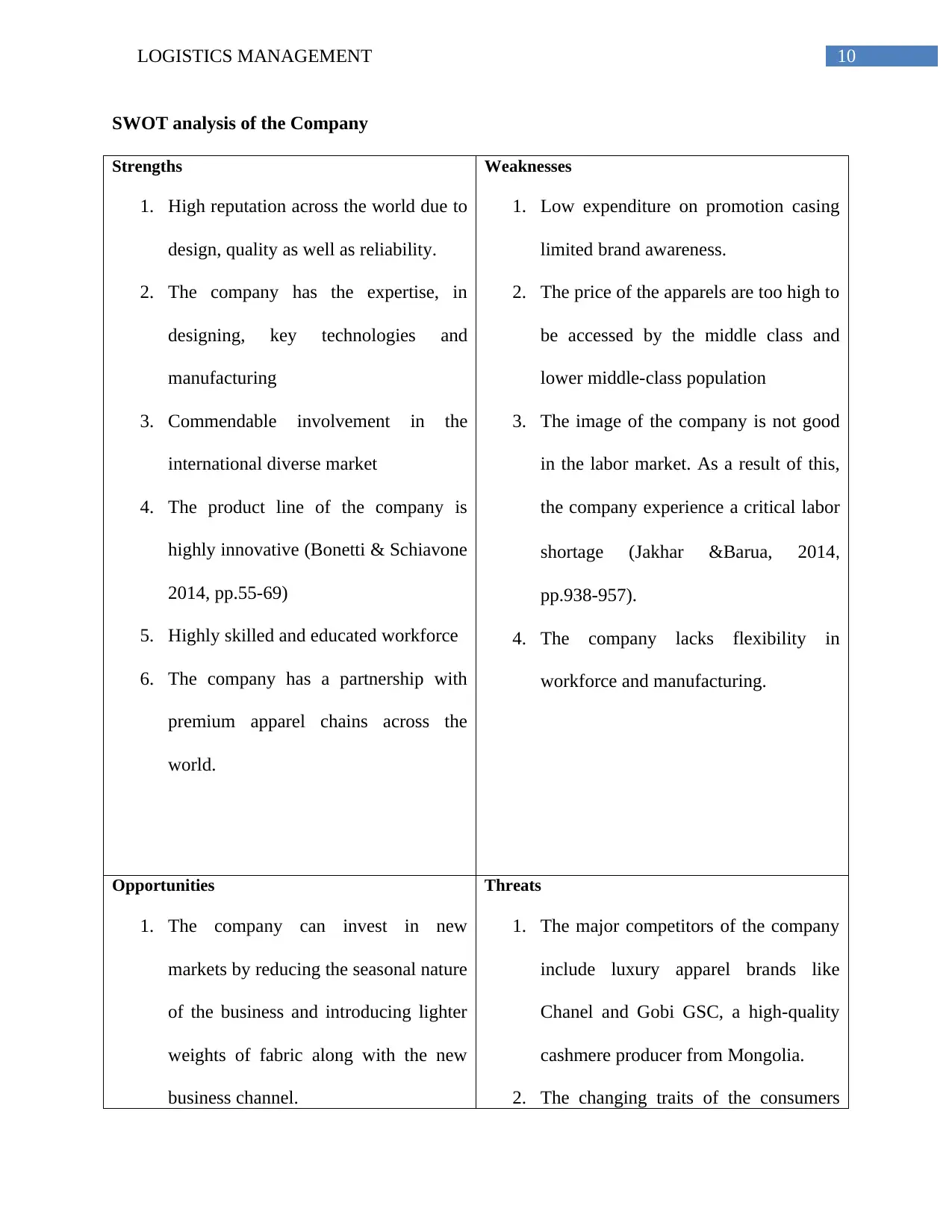
10LOGISTICS MANAGEMENT
SWOT analysis of the Company
Strengths
1. High reputation across the world due to
design, quality as well as reliability.
2. The company has the expertise, in
designing, key technologies and
manufacturing
3. Commendable involvement in the
international diverse market
4. The product line of the company is
highly innovative (Bonetti & Schiavone
2014, pp.55-69)
5. Highly skilled and educated workforce
6. The company has a partnership with
premium apparel chains across the
world.
Weaknesses
1. Low expenditure on promotion casing
limited brand awareness.
2. The price of the apparels are too high to
be accessed by the middle class and
lower middle-class population
3. The image of the company is not good
in the labor market. As a result of this,
the company experience a critical labor
shortage (Jakhar &Barua, 2014,
pp.938-957).
4. The company lacks flexibility in
workforce and manufacturing.
Opportunities
1. The company can invest in new
markets by reducing the seasonal nature
of the business and introducing lighter
weights of fabric along with the new
business channel.
Threats
1. The major competitors of the company
include luxury apparel brands like
Chanel and Gobi GSC, a high-quality
cashmere producer from Mongolia.
2. The changing traits of the consumers
SWOT analysis of the Company
Strengths
1. High reputation across the world due to
design, quality as well as reliability.
2. The company has the expertise, in
designing, key technologies and
manufacturing
3. Commendable involvement in the
international diverse market
4. The product line of the company is
highly innovative (Bonetti & Schiavone
2014, pp.55-69)
5. Highly skilled and educated workforce
6. The company has a partnership with
premium apparel chains across the
world.
Weaknesses
1. Low expenditure on promotion casing
limited brand awareness.
2. The price of the apparels are too high to
be accessed by the middle class and
lower middle-class population
3. The image of the company is not good
in the labor market. As a result of this,
the company experience a critical labor
shortage (Jakhar &Barua, 2014,
pp.938-957).
4. The company lacks flexibility in
workforce and manufacturing.
Opportunities
1. The company can invest in new
markets by reducing the seasonal nature
of the business and introducing lighter
weights of fabric along with the new
business channel.
Threats
1. The major competitors of the company
include luxury apparel brands like
Chanel and Gobi GSC, a high-quality
cashmere producer from Mongolia.
2. The changing traits of the consumers
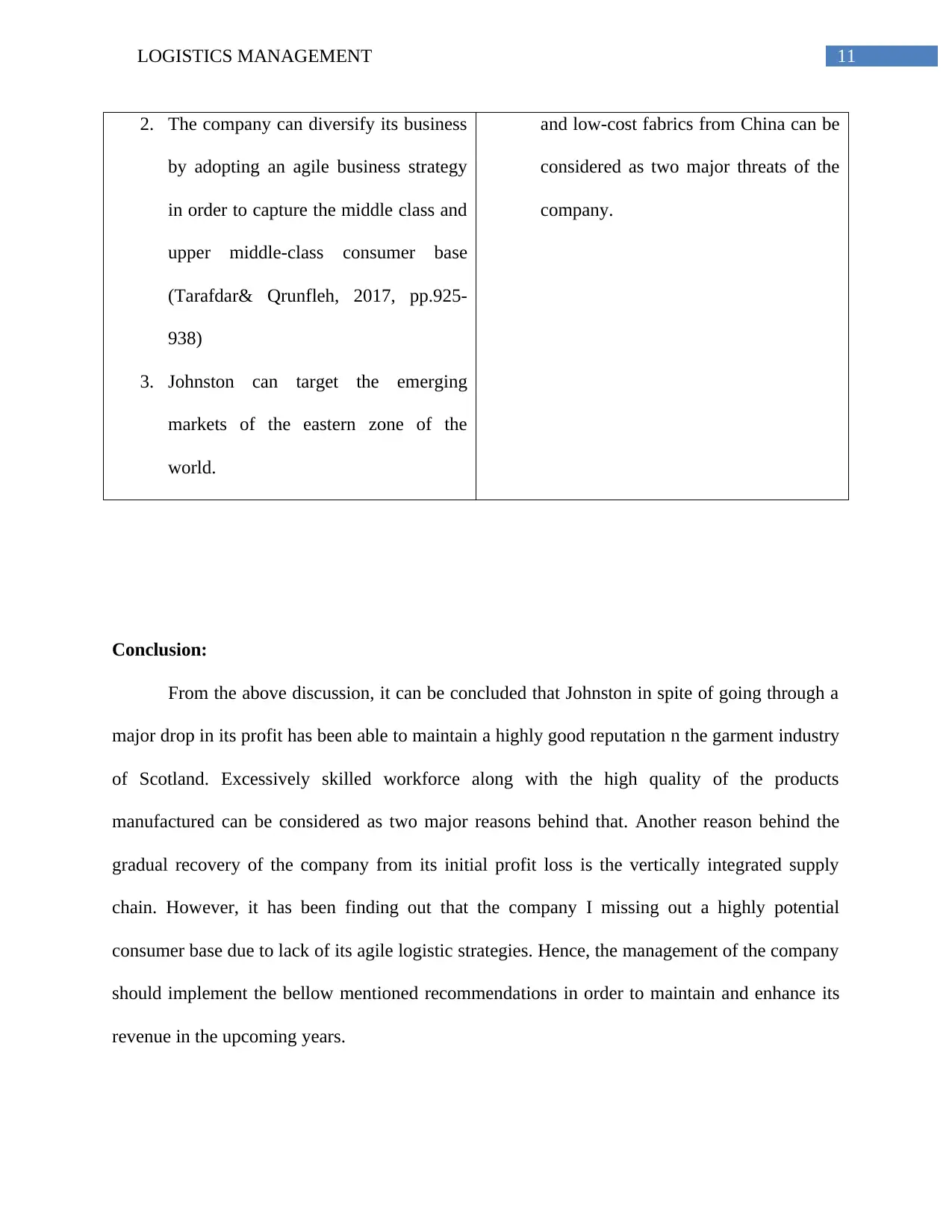
11LOGISTICS MANAGEMENT
2. The company can diversify its business
by adopting an agile business strategy
in order to capture the middle class and
upper middle-class consumer base
(Tarafdar& Qrunfleh, 2017, pp.925-
938)
3. Johnston can target the emerging
markets of the eastern zone of the
world.
and low-cost fabrics from China can be
considered as two major threats of the
company.
Conclusion:
From the above discussion, it can be concluded that Johnston in spite of going through a
major drop in its profit has been able to maintain a highly good reputation n the garment industry
of Scotland. Excessively skilled workforce along with the high quality of the products
manufactured can be considered as two major reasons behind that. Another reason behind the
gradual recovery of the company from its initial profit loss is the vertically integrated supply
chain. However, it has been finding out that the company I missing out a highly potential
consumer base due to lack of its agile logistic strategies. Hence, the management of the company
should implement the bellow mentioned recommendations in order to maintain and enhance its
revenue in the upcoming years.
2. The company can diversify its business
by adopting an agile business strategy
in order to capture the middle class and
upper middle-class consumer base
(Tarafdar& Qrunfleh, 2017, pp.925-
938)
3. Johnston can target the emerging
markets of the eastern zone of the
world.
and low-cost fabrics from China can be
considered as two major threats of the
company.
Conclusion:
From the above discussion, it can be concluded that Johnston in spite of going through a
major drop in its profit has been able to maintain a highly good reputation n the garment industry
of Scotland. Excessively skilled workforce along with the high quality of the products
manufactured can be considered as two major reasons behind that. Another reason behind the
gradual recovery of the company from its initial profit loss is the vertically integrated supply
chain. However, it has been finding out that the company I missing out a highly potential
consumer base due to lack of its agile logistic strategies. Hence, the management of the company
should implement the bellow mentioned recommendations in order to maintain and enhance its
revenue in the upcoming years.
⊘ This is a preview!⊘
Do you want full access?
Subscribe today to unlock all pages.

Trusted by 1+ million students worldwide
1 out of 15
Related Documents
Your All-in-One AI-Powered Toolkit for Academic Success.
+13062052269
info@desklib.com
Available 24*7 on WhatsApp / Email
![[object Object]](/_next/static/media/star-bottom.7253800d.svg)
Unlock your academic potential
Copyright © 2020–2025 A2Z Services. All Rights Reserved. Developed and managed by ZUCOL.



